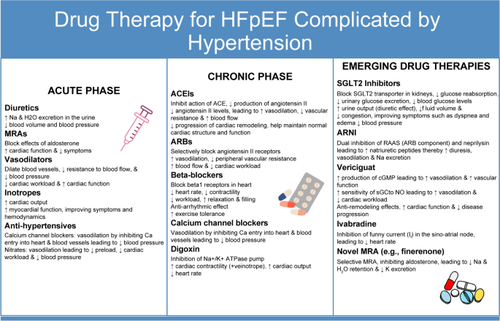American Journal of Cardiovascular Drugs ( IF 3 ) Pub Date : 2024-04-04 , DOI: 10.1007/s40256-024-00641-9 Hiroaki Hiraiwa , Takahiro Okumura , Toyoaki Murohara

|
In this comprehensive state-of-the-art review, we provide an evidence-based analysis of current drug therapies for patients with heart failure with preserved ejection fraction (HFpEF) in the acute and chronic phases with concurrent hypertension. Additionally, we explore the latest developments and emerging evidence on the efficacy, safety, and clinical outcomes of common and novel drug treatments in the management of HFpEF with concurrent hypertension. During the acute phase of HFpEF, intravenous diuretics, mineralocorticoid receptor antagonists (MRAs), and vasodilators are pivotal, while in the chronic phase, angiotensin-converting enzyme inhibitors and angiotensin receptor blockers have proven effective in enhancing clinical outcomes. However, the use of calcium channel blockers in HFpEF with hypertension should be approached with caution, owing to their potential negative inotropic effects. We also explored emerging drug therapies for HFpEF, such as sodium–glucose co-transporter 2 (SGLT2) inhibitors, angiotensin receptor–neprilysin inhibitor (ARNI), soluble guanylate cyclase (sGC) stimulators, novel MRAs, and ivabradine. Notably, SGLT2 inhibitors have shown promise in reducing heart failure hospitalizations and cardiovascular mortality in patients with HFpEF, regardless of their diabetic status. Additionally, ARNI and sGC stimulators have demonstrated potential in improving symptoms, functional capacity, and quality of life. Nonetheless, additional research is necessary to pinpoint optimal treatment strategies for HFpEF with concurrent hypertension. Furthermore, long-term studies are essential to assess the durability and sustained benefits of emerging drug therapies. Identification of novel targets and mechanisms underlying HFpEF pathophysiology will pave the way for innovative drug development approaches in the management of HFpEF with concurrent hypertension.
中文翻译:

保留射血分数并伴有高血压的急性和慢性心力衰竭的药物治疗:最先进的综述
在这篇全面的最新综述中,我们对急性期和慢性期射血分数保留(HFpEF)并发高血压的心力衰竭患者的当前药物治疗进行了循证分析。此外,我们还探讨了常见和新型药物治疗 HFpEF 并发高血压的疗效、安全性和临床结果的最新进展和新证据。在HFpEF的急性期,静脉利尿剂、盐皮质激素受体拮抗剂(MRA)和血管扩张剂是关键,而在慢性期,血管紧张素转换酶抑制剂和血管紧张素受体阻滞剂已被证明可有效改善临床结果。然而,由于钙通道阻滞剂潜在的负性肌力作用,在高血压 HFpEF 中使用钙通道阻滞剂应谨慎。我们还探索了针对 HFpEF 的新兴药物疗法,例如钠-葡萄糖协同转运蛋白 2 (SGLT2) 抑制剂、血管紧张素受体-脑啡肽酶抑制剂 (ARNI)、可溶性鸟苷酸环化酶 (sGC) 刺激剂、新型 MRA 和伊伐布雷定。值得注意的是,SGLT2 抑制剂在减少 HFpEF 患者的心力衰竭住院率和心血管死亡率方面表现出了希望,无论其糖尿病状况如何。此外,ARNI 和 sGC 刺激器已显示出改善症状、功能能力和生活质量的潜力。尽管如此,还需要进行更多研究来确定 HFpEF 并发高血压的最佳治疗策略。此外,长期研究对于评估新兴药物疗法的持久性和持续益处至关重要。识别 HFpEF 病理生理学的新靶点和机制将为治疗 HFpEF 合并高血压的创新药物开发方法铺平道路。



























 京公网安备 11010802027423号
京公网安备 11010802027423号